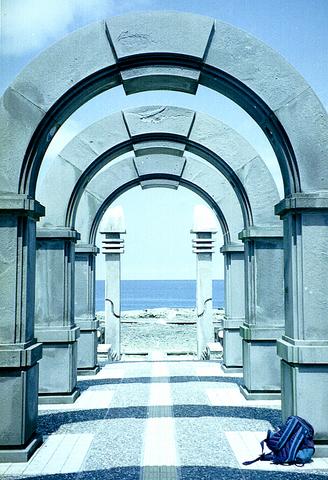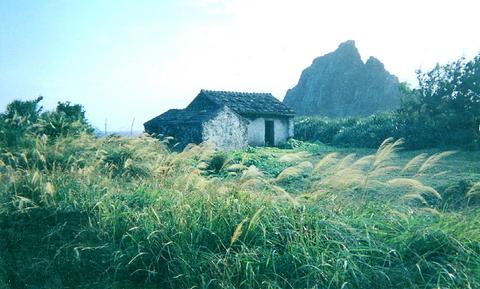Green Island, or Lu Tao (
The 15km2 lump of volcanic rock pokes out of the blue Pacific, 33km off the southeast coast of Taiwan, in Taitung County. It is ringed by some of the best coral reefs in the country, blessed by sun most of the year and has abundant flora and fauna, sweeping views and one of only three seawater hot springs in the world.
It holds special significance for the governing DPP because many of its leaders were jailed there by the KMT, along with an estimated 25,000 other political or criminal prisoners. This was when the island was home to a maximum security prison from the late 1940s to late 1980s.

PHOTO: GAVIN PHIPPS, TAIPEI TIMES
When Minister of Justice Chen Ding-nan (
When locals complained they would lose jobs with the prison service and said many of the small support industries would likely be have to close, Chen was undeterred and told them tourism was the answer.
So far, so good.

PHOTO: DAVID MOMPHARD, TAIPEI TIMES
Green Island is drawing around 6,000 visitors a week and weekends can get pretty packed, with gaggles of college students, small bunches of foreigners and extended families jostling for motorbikes, swarming restaurants and competing for places on snorkeling excursions, glass-bottomed boats and submarine tours.
We went by plane to Taitung from Taipei, which cost NT$2,500 return and takes around 40 minutes. It's 30 minutes by minivan to the port, where there is a place to eat some food at the small and traditional indoor market and buy low-fashion sunglasses and sunblock cream. Or one canwatch the fishing boats, the small guy who waves his arms around in angry little swirls when people don't give him money, the ferry captain who says, "This is your captain, Osama bin Laden," or other signs of harbor-life.
The boat trip cost NT$600 one-way to Green Island and was an uneventful 40 minutes, with most passengers sticking to their seats and dozing. There was no chance of seeing whales or dolphins, though special trips to see these mammals can be chartered from Green Island.

There are no four-star hotels on the island -- though one is planned -- so if it's a high standard of comfort you are looking for, Green Island isn't for you. What's left is a modest but clean cut of hotel, with TV, AC and WC, all the necessary acronyms. Prices are in the NT$1,000 to NT$2,000 range, but there is a "youth hostel" which rents out rooms to groups of four to eight people.
One road goes round the island and it can be walked in six hours or circumnavigated on a motorbike in half an hour. There are some other small roads inland that are loosely connected and are good for hiking. Bikes are another option.
The average annual temperature is 26℃, which translates as a lot of days when the sun is a high, white ball in a thin blue sky. There is enough rain to keep the island green but in winter the northeasterly monsoon whips up waves which shower the island in "salty rain."
There are plenty of trails to explore. One leads inland and up an extinct crater to a grotto which contains the statue of Kuanyin (觀音), a stalagmite draped in a cloak to look like the goddess of mercy. On other walks there are old houses stranded on the hills, some with trees growing out of their tops. Along the coastline there are plenty of beautiful spots for posed photos and a couple of beaches -- more pebble and coral than sand.
Like most people we went to the Chao Jih (
The hot springs are run by a company that has similar facilities in Japan and elsewhere. It has added changing rooms, three pools (hot, warm, cold) and a relaxation area close to the natural hot springs by the sea, which are reached by a path. When we were there a small typhoon rolled by and it was a spectacular son et lumiere as the skies lit up in the distance with electric energy, as we lay in a bath.
Afterwards, it was time to try out the restaurants in the small town of Chungliao. Local meats include wild pig, goat, deer and rainbow trout. Island-grown vegetables, mushrooms, millet cakes and food cooked in bamboo all combine with plentiful fresh seafood. It's simple but honest fare and the sashimi is good.
Green Island has been a sleepy place that hasn't changed much physically for 3,000 years, when it was a stopping off point for Austranesian migrations. But in the last 15 or so years it has developed 30 small hotels, restaurants, a small airport providing 10-minute flights to Taitung and other tourist infrastructure.
Like the country's politics, change in the 1980s brought benefits. Green Island was judged to be an area of outstanding natural beauty in 1986 and a tourism industry was spawned.
Many visitors came not just for nature but to take a look for themselves at the physical manifestation of Taiwan's White Terror era of political repression. Partly in pilgrimage, partly because any marketing hook will do, tourists buy up ball and chain key rings and gather outside the prison to wonder at what went on behind the walls not so long ago.
Nearby, is the tiny Human Rights Park and memorial to those who perished in Green Island Prison, the biggest sign that times have changed. It's a stone structure that blends in with the landscape, partly sunk in the ground by the coast. Water runs from a well at the top all the way down a spiralling viaduct, that ends in a fall of water from a ring set in the stone column.
Instead of White Terror there is democracy. The prison is being dismantled and rather than inmates there are tourists. There are even plans to turn the prison into a permanent attraction.
There are concerns, however, that outside investment by the government and business will lead to over-exploitation. The tourism bureau must balance more visitors against the inevitable destruction of the island's coral reefs and inland habitats so there are limits to its natural development.
There are no more "devils" on Green Island and it has changed for the better, but it will never have the surf of Penghu, the culture of Orchid Island or the tourist potential of places like Bali, Ko Samui or Cheju Island in South Korea.
Green Island has changed for the better, but it's not paradise and never will be, if that place could be defined as somewhere you wouldn't mind spending forever in.
For a weekend break, however, it is perfect.

April 14 to April 20 In March 1947, Sising Katadrepan urged the government to drop the “high mountain people” (高山族) designation for Indigenous Taiwanese and refer to them as “Taiwan people” (台灣族). He considered the term derogatory, arguing that it made them sound like animals. The Taiwan Provincial Government agreed to stop using the term, stating that Indigenous Taiwanese suffered all sorts of discrimination and oppression under the Japanese and were forced to live in the mountains as outsiders to society. Now, under the new regime, they would be seen as equals, thus they should be henceforth

Last week, the the National Immigration Agency (NIA) told the legislature that more than 10,000 naturalized Taiwanese citizens from the People’s Republic of China (PRC) risked having their citizenship revoked if they failed to provide proof that they had renounced their Chinese household registration within the next three months. Renunciation is required under the Act Governing Relations Between the People of the Taiwan Area and the Mainland Area (臺灣地區與大陸地區人民關係條例), as amended in 2004, though it was only a legal requirement after 2000. Prior to that, it had been only an administrative requirement since the Nationality Act (國籍法) was established in

Three big changes have transformed the landscape of Taiwan’s local patronage factions: Increasing Democratic Progressive Party (DPP) involvement, rising new factions and the Chinese Nationalist Party’s (KMT) significantly weakened control. GREEN FACTIONS It is said that “south of the Zhuoshui River (濁水溪), there is no blue-green divide,” meaning that from Yunlin County south there is no difference between KMT and DPP politicians. This is not always true, but there is more than a grain of truth to it. Traditionally, DPP factions are viewed as national entities, with their primary function to secure plum positions in the party and government. This is not unusual

US President Donald Trump’s bid to take back control of the Panama Canal has put his counterpart Jose Raul Mulino in a difficult position and revived fears in the Central American country that US military bases will return. After Trump vowed to reclaim the interoceanic waterway from Chinese influence, US Defense Secretary Pete Hegseth signed an agreement with the Mulino administration last week for the US to deploy troops in areas adjacent to the canal. For more than two decades, after handing over control of the strategically vital waterway to Panama in 1999 and dismantling the bases that protected it, Washington has